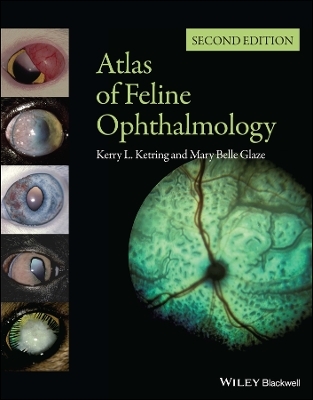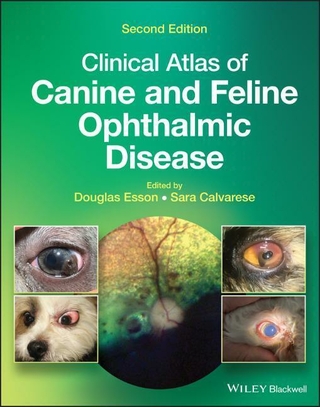
Atlas of Feline Ophthalmology
Wiley-Blackwell (Verlag)
978-0-470-95874-2 (ISBN)
Atlas of Feline Ophthalmology
Successful management of eye disease relies on the veterinarian’s ability to identify ocular features and distinguish pathologic changes. Atlas of Feline Ophthalmology, Second Edition is an invaluable diagnostic reference, providing high-quality color photographs for comparison with a presenting complaint. Presenting 394 photographs illustrating both normal and pathologic ocular conditions, this Second Edition offers a current, complete reference on ocular diseases, adding conditions recognized since publication of the first edition, a broader geographic scope, and many new images with improved quality.
Carefully designed for easy reference, the contents are divided into sections corresponding to specific anatomical structures of the eye. A useful appendix new to this edition groups figures by etiology, making it easy to find every image associated with a specific agent or disease. Atlas of Feline Ophthalmology, Second Edition is a useful tool aiding general practitioners in diagnosing eye disease in cats.
Key Features
Provides a compendium of high-quality color images of the feline eye
Focuses on the identification of a global list of diseases, conditions, and injuries affecting the eye
Includes both normal and pathologic ocular conditions
Acts as a diagnostic tool, with therapeutic information omitted by design
Aids clinicians in using ocular examinations to diagnose systemic disease
Designed for easy reference, with the book divided into sections according to ocular anatomical structures and an appendix grouping figures by etiology
The Authors Kerry L. Ketring, DVM, DACVO, a veterinary ophthalmologist, was in private practice in Ohio and Kentucky for 32 years; he retired to Michigan, where he continues to see clients. He also lectures nationally and internationally. Mary Belle Glaze, DVM, MS, DACVO, is a veterinary ophthalmologist at the Gulf Coast Animal Eye Clinic, a private referral practice in Houston, Texas. Prior to that she was on staff at Louisiana State University’s Veterinary Teaching Hospital for 20 years and is a past president of the American College of Veterinary Ophthalmologists. She also lectures nationally and internationally.
Listing of Breed Predispositions to Ocular Disease . . . page xvii
I. Normal Eye
A. Diagrams
1. Cross-sectional 1
2. Fundus oculus 2
B. Normal adnexa/anterior segment
1. Frontal view 3, 4
2. Lateral view
a. Lens and cornea 5
b. Gross angle 6
3. Iridocorneal angle—Gonioscopic view 7
C. Normal fundus 8–17
II. Globe–Orbit Relationship
A. Convergent strabismus 18
B. Enophthalmos
1. Microphthalmia 19
2. Phthisis bulbi 20
3. Horner’s syndrome 21
4. Retrobulbar tumor 22
5. Pain 37, 40, 42, 76, 125, 143
C. Exophthalmos
1. Cellulitis/Retrobulbar abscess 23–25
2. Neoplasia
a. Retrobulbar lymphoma 26
b. Zygomatic osteoma 27
3. Orbital pseudotumor 28, 29
D. Proptosis 30
E. Orbitalmucocele 31, 32
III. Adnexa
A. Eyelid agenesis 33–36
B. Entropion 37
C. Ectropion 38
D. Distichiasis 39
E. Blepharitis
1. Herpetic 40, 54
2. Allergic blepharitis 41, 42, 51
3. Bacterial blepharitis 43
4. Meibomianitis 44
5. Demodicosis 49
6. Mycobacterial dermatitis 50
7. Food allergy 52
8. Pemphigus erythematosus 53
9. Persian idiopathic facial dermatitis 55
F. Apocrine cystadenoma 45, 46
G. Chalazion 47
H. Lipogranulomatous conjunctivitis 48
I. Granuloma/Histoplasmosis 68
J. Neoplasia
1. Cutaneous histiocytosis 56
2. Squamous cell carcinoma 57–59
3. Adenocarcinoma 60, 61
4. Mast cell tumor 62–64
5. Melanoma 65
6. Periorbital lymphoma 66
7. Nerve sheath tumor 67
IV. Conjunctiva
A. Dermoid 36, 69, 70
B. Symblepharon72–75, 102
C. Conjunctivitis
1. Infectious
a. Herpesvirus 76, 77, 83
b. Chlamydophila 78–80, 84
c. Bartonella 81, 83, 84
d. Mycoplasma 82
e. Polymicrobial 83, 84
f. Ophthalmia neonatorum 71
g. Leishmania 88
h. Blastomycosis 89
i. Histoplasmosis 90
2. Allergic
a. Insect sting 85
b. Drug reaction 42
3. Eosinophilic 86, 87, 104, 151
4. Traumatic94
5. Conjunctival cysts 92, 93
6. Parasitic-Thelaziasis 95
D. Dacryocystitis 96
E. Neoplasia
1. Lymphoma 91
2. Melanoma 97, 98
V. Nictitating Membrane
A. Nictitans protrusion
1. Idiopathic prolapsed nictitating membrane 99
2. Glandular prolapse 100
3. Everted cartilage 101
4. Symblepharon 102, 113
5. Horner’s syndrome 21
6. Abscess 103
7. Retrobulbar neoplasia 22
8. Phthisis bulbi 20
9. Pain 37, 40, 42, 76, 125, 143
B. Eosinophilic conjunctivitis 104
C. Neoplasia
1. Fibrosarcoma 105
2. Squamous cell carcinoma 106, 107
3. Lymphoma 108
4. Plasmacytoma 109
VI. Cornea
A. Corneal opacities
1. Persistent pupillary membranes 110–112, 171, 172
2. Adherent leukoma 113, 158, 159
3. Corneal degeneration 114, 115
4. Florida spots 116, 117
5. Storage disease (MPS-VI) 118
6. Relapsing polychondritis 119
B. Congenital Endothelial Dysfunction 123
C. Keratoconus 120, 121
D. Manx dystrophy 122
E. Infectious keratitis
1. Viral keratitis-Herpetic
a. Punctate 124
b. Dendritic 125, 126
c. Geographic 107, 127–131, 147, 153
2. Mycoplasma 132, 133
3. Bacterial
a. Staphylococcus 134
b. Pseudomonas 135
4. Fungal
a. Candida 136
b. Aspergillus 137
5. Mycobacterial 138, 139
F. Ulcerative keratitis
1. Superficial ulceration
a. Keratoconjunctivitis sicca 25, 140, 153, 175, 176
b. Neurotrophic 140
2. Bullous keratitis 141
3. Bullous keratopathy 142
4. Descemetocele 143, 144
5. Iris prolapse 35, 145
G. Corneal Laceration 146
H. Eosinophilic keratitis 107, 147–151
I. Corneal sequestration 37, 152–155
J. Foreign body 156
K. Staphyloma 157–159
L. Neoplasia
1. Limbal melanocytoma (Scleral shelf melanoma, Epibulbar melanoma) 160–162
2. Neuroblastic 163
3. Squamous cell carcinoma 164
VII. Anterior Uvea
A. Dyscorias
1. Iris coloboma 36, 165, 166
2. Corectopia 167
3. Idiopathic dyscoria 168
4. D-shaped pupil 169
5. Spastic pupil syndrome 170
B. Persistent pupillary membranes 110–112, 171, 172, 272
C. Chediak-Higashi syndrome 173
D. Iris atrophy 174
E. Dysautonomia 175, 176
F. Iris cysts/Iridocilary cysts 177–179, 267
G. Anterior uveitis
1. Iris abscess 184
2. Viral
a. Feline leukemia complex/ Lymphoma 180–183, 185–190
b. FIV 190, 191
c. FIP 192–196
3. Toxoplasmosis 197–202
4. Fungal
a. Histoplasmosis 202–206
b. Cryptococcosis 207, 208
c. Blastomycosis 209, 210
d. Coccidioidomycosis 211
5. Bartonellosis 213–216, 244
6. Polymicrobial 190, 202, 212
7. Parasitic
a. Dirofilariasis 217
b. Myiasis 218
8. Metabolic/Hypertension
a. Hyperlipidemia 219
b. Systemic hypertension 220, 221
9. Trauma 222, 223
10. Lens Induced
a. Phacolytic 276
b. Septic lens implantation 224
11. Neoplasia
a. Feline diffuse iris melanoma (FDIM) 225, 226, 229, 231, 269, 270
b. Iris melanoma 227, 228
c. Iris amelanotic melanoma 227, 230, 232
d. Iridociliary adenoma 233–236
e. Spindle cell tumor 237
f. Iridociliary leiomyoma 238
g. Iridociliary leiomyosarcoma 239, 240
h. Metastatic mammary adenocarcinoma 241
i. Squamous cell carcinoma 242
j. Metastatic hemangiosarcoma 243
k. Primitive neural epithelial tumor 244
l. Post-traumatic sarcoma 245, 246
12. Post-inflammatory sequelae
a. Lens capsule pigmentation 247, 250
b. Posterior synechia/Iris bombé 248, 249
c. Cataract 247, 248, 250
d. Anterior lens luxation 286
e. Iris cysts 179
f. Glaucoma 264–266, 268–270
VIII. Glaucoma
A. Congenital/Goniodysgenesis 251, 252, 261, 262, 288, 388
B. Inherited/Primary Open Angle Glaucoma (POAG)
1. Siamese 253
2. Domestic shorthair 254–257
C. Feline Aqueous Humor Misdirection Syndrome (FAHMS) 258–260
D. Secondary
1. Post-inflammatory/Infectious 209, 224, 263–265, 289
2. Systemic Hypertension 266
3. Iridocilary cysts 267
4. Neoplastic
a. Spindle cell tumor 237
b. Lymphoma 190, 268
c. Feline diffuse iris melanoma (FDIM) 232, 269, 270, 389
IX. Lens
A. Senile nuclear sclerosis 271
B. Cataract
1. Congenital/Persistent pupillary membranes 272, 274–277
2. Nutritional 273
3. Inherited 173, 275
4. Cataract resorption 277–279, 281
5. Trauma/Post-inflammatory 245–248, 280–282
6. Hypocalcemic 285
C. Cataract classification by involvement
1. Incipient 224, 247, 248, 258, 272, 273, 282, 285
2. Immature 173, 239, 247, 248, 274, 275, 280, 283
3. Mature 250, 260
4. Hypermature/Phacolytic uveitis 276, 284
5. Cataract resorption 19, 277–279, 281
D. Encephalitozoon cuniculi 283, 284
E. Lens luxation
1. Anterior 259, 260, 286, 288, 289
2. Posterior 254, 255, 257, 287
3. Subluxation 160, 256
X. Vitreous
A. Persistent hyaloid 288
B. Vitreous hemorrhage 292
C. Hyalitis
1. FIV 289
2. Toxoplasmosis 290
3. Pyogranulomatous inflammation 291
4. Retinal detachment/Systemic hypertension 292
XI. Retina and choroid
A. Congenital
1. Cardiovascular Anomalies 293
2. Coloboma 294, 295
3. Retinal Folds 296, 297
B. Chorioretinitis-Infectious
1. Feline leukemia complex 298–301
2. Panleukopenia 302
3. Feline infectious peritonitis 303–308
4. Fungal conditions
a. Histoplasmosis 309–313, 386
b. Cryptococcosis 314–319
c. Blastomycosis 320–322
d. Coccidioidomycosis 323, 324
5. Toxoplasmosis 325–331
6. Feline hemotropic mycoplasmosis (feline infectious anemia) 332
7. Bacterial 333
8. Ophthalmomyiasis 334, 335
C. Chorioretinitis-Traumatic 336, 349, 350
D. Hypertensive retinopathy 337–347
E. Retinal detachment
1. Renal failure/Systemic hypertension 338, 342–345
2. Trauma 348
3. Neoplasia 373, 374, 376
4. Infectious 308, 312, 313, 318, 321, 323, 331
F. Retinal folds
1. Dysplastic 296, 297
2. Inflammatory 305, 338
3. Traumatic 350
4. Neoplasia 371, 372
G. Retinopathy
1. Fluoroquinolone 354, 355
2. Feline central retinal degeneration (FCRD) 356–358
3. Feline generalized retinal atrophy (FGRA) 359–361
4. Post-trauma/Inflammation 351, 352, 387
5. Idiopathic 353
6. Progressive retinal atrophy (PRA)
a. Abyssinian 362, 363
b. Tonkinese 364
c. Burmese 365
d. Siamese 366
7. Chediak-Higashi syndrome 367
H. Vascular changes
1. Lipemia retinalis 368, 369
2. Cardiovascular anomalies 293
3. Hyperviscosity 306
I. Neoplasia
1. Plasma cell tumor 370
2. Retrobulbar 373, 374
3. Lymphoma 371, 372
4. Metastatic intestinal adenocarcinoma 375
5. Metastatic adenocarcinoma 376, 378
6. Metastatic hemangiosarcoma 377
XII. Optic nerve
A. Coloboma 379, 380
B. Optic disc hypoplasia 381
C. Optic disc aplasia 382, 383
D. Optic neuritis
1. Cryptococcosis 319, 384
2. Toxoplasmosis 331
E. Optic nerve atrophy 385–389, 394
F. Glaucoma 388, 389
G. Neoplasia
1. Glioma 390
2. Lymphosarcoma 391, 392
3. Meningioma 393, 394
Bibliography page 155
Systemic Disease Related Images page 173
| Erscheint lt. Verlag | 27.3.2012 |
|---|---|
| Verlagsort | Hoboken |
| Sprache | englisch |
| Maße | 221 x 279 mm |
| Gewicht | 794 g |
| Themenwelt | Veterinärmedizin ► Klinische Fächer ► Ophthalmologie |
| Veterinärmedizin ► Kleintier | |
| ISBN-10 | 0-470-95874-X / 047095874X |
| ISBN-13 | 978-0-470-95874-2 / 9780470958742 |
| Zustand | Neuware |
| Haben Sie eine Frage zum Produkt? |
aus dem Bereich


